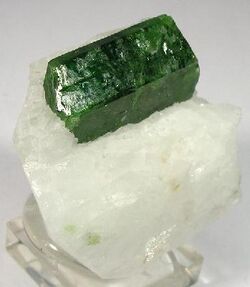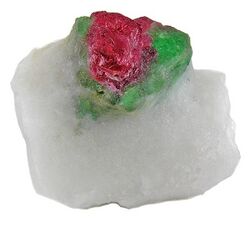Chemistry:Pargasite
From HandWiki
Short description: Amphibole, double chain inosilicate mineral
| Pargasite | |
|---|---|
 Single crystal of pargasite, 1.5 cm long, on a matrix of white marble from Hunza Valley, Pakistan | |
| General | |
| Category | Inosilicates |
| Formula (repeating unit) | NaCa2(Mg4Al)(Si6Al2)O22(OH)2 |
| Strunz classification | 9.DE.15 |
| Dana classification | 66.1.3a.12 |
| Crystal system | Monoclinic |
| Crystal class | Prismatic (2/m) (same H-M symbol) |
| Space group | C2/m |
| Identification | |
| Color | Bluish green, grayish black, light brown |
| Crystal habit | Stout prismatic to tabular |
| Twinning | Simple and lamellar – common |
| Cleavage | {110} perfect |
| Fracture | Splintery |
| Mohs scale hardness | 5–6 |
| |re|er}} | Vitreous |
| Diaphaneity | Translucent, will transmit light on thin edges. |
| Specific gravity | 3.04–3.17 |
| Optical properties | Biaxial (−) |
| Refractive index | nα = 1.630 nβ = 1.640 nγ = 1.650 |
| Birefringence | δ = 0.020 max. |
| References | [1][2][3][4][5] |
Pargasite is a complex inosilicate mineral of the amphibole group with formula NaCa2(Mg4Al)(Si6Al2)O22(OH)2.
It was first described for an occurrence in Pargas, Finland in 1814 and named for the locality.[5]
It occurs in high temperature regional metamorphic rocks and in the skarns within contact aureoles around igneous intrusions. It also occurs in andesite volcanic rocks and altered ultramafic rocks.[2]
Pargasite is the main water-storage site in the uppermost mantle; however, it becomes unstable at depths greater than 90 km (56 mi). This has significant consequences for the water storage capacity, and the solidus temperature of the lherzolite of the upper mantle.[7]
It is used as a gemstone.[8][9]
See also
References
- ↑ Mineralienatlas
- ↑ 2.0 2.1 "Pargasite" (pdf). Handbook of Mineralogy. Mineralogical Society of America. http://www.handbookofmineralogy.org/pdfs/pargasite.pdf. Retrieved 2012-12-17.
- ↑ "IMA Master List". http://pubsites.uws.edu.au/ima-cnmnc/.
- ↑ "Pargasite". mindat.org. http://www.mindat.org/min-3119.html.
- ↑ 5.0 5.1 "Pargasite Mineral Data". webmineral.com. http://webmineral.com/data/Pargasite.shtml. (Java plugin required)
- ↑ Warr, L.N. (2021). "IMA–CNMNC approved mineral symbols". Mineralogical Magazine 85 (3): 291–320. doi:10.1180/mgm.2021.43. Bibcode: 2021MinM...85..291W.
- ↑ Green, D H; Hibberson, W O; Kovacs, Istvan; Rosenthal, A (23 September 2010). "Water and its influence on the lithosphere–asthenosphere boundary". Nature 467 (7314): 448–451. doi:10.1038/nature09369. PMID 20865000. Bibcode: 2010Natur.467..448G.
- ↑ Dedeyne, Roger; Quintens, Evo (2007). Tables of gemstone identification (1st ed.). Gent, Belgium: Glirico. p. 169. ISBN 9789078768012. https://books.google.com/books?id=wnEAcCPBVOsC&q=Tables+of+Gemstone+Identification+By+Roger+Dedeyne,+Ivo+Quintens,+p.169&pg=PA5. Retrieved 5 November 2020.
- ↑ "Amethyst Crystals and Meaning Healing Properties" (in en-US). 2022-07-11. https://nacrystal.com/amethyst-meaning-and-healing-properties/.

 |
